The history of architecture has given away us impressive presents in the course of time. While some of them have been very famous architectural structures, most of them have vanished. In this article, we have compiled the 22 most famous buildings in the world.
Compilation of the Most Famous Buildings in Architecture
1. Heydar Aliyev Center | Zaha Hadid
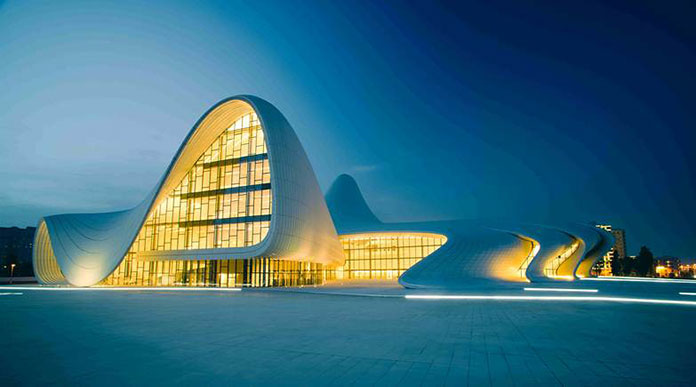
| Architect: Zaha Hadid |
| Location: Baku, Azerbaijan |
| Construction period: 2007-2012 |
| Structure material: Steel and reinforced concrete |
| Architectural style: Deconstructivism |
This building was designed by one of the greatest modernist architects Zaha Hadid in 2007. Located in Baku, Azerbaijan, Heydar Aliyev Cultural Center has stuck in my mind with its folded form resembling sea waves. Starting from the ground level, this fluid form bends to create infinitive angles as well as unlimited potential for interactions of various architectural elements.
Zaha Hadid avoided creating sharp lines in the design of the building and wanted to move away from the monumental architecture of the Soviet Union. Instead, she created a core structure with reinforced concrete in the middle of Heydar Aliyev Center and left the form free with the help of a specially designed space frame system.
Read Also: Heydar Aliyev Center in Baku | Zaha Hadid Architects
2. Bilbao Guggenheim Museum | Frank Gehry
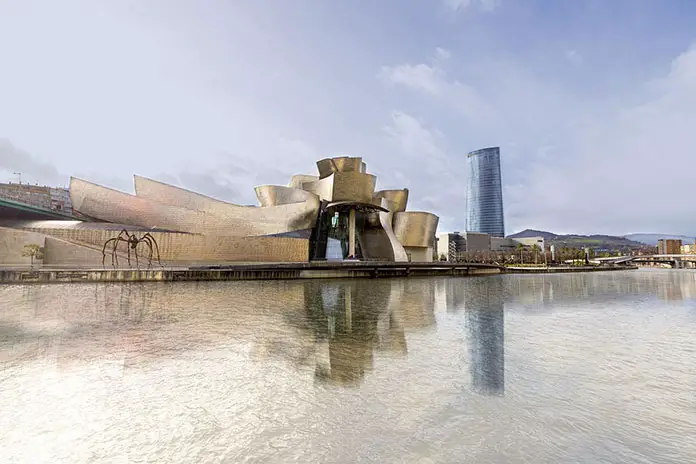
| Architect: Frank Gehry |
| Location: Bilbao, Spain |
| Construction period: 1993-1997 |
| Structure material: Steel |
| Architectural style: Deconstructivism |
Completed in 1997, Guggenheim Bilbao Museum is one of the most famous buildings in the world and is considered among the pioneers of Deconstructivism Architecture. Frank Gehry designed this building, located in the riverside of Bilbao city, to contribute to the renovation program of the Bilbao Port.
The form of the building resembles a sailing ship and it refers to the history of this port city. Covered with titanium panels, Bilbao Guggenheim Museum is the most important building of Frank Gehry in Spain.
Read Also: Bilbao Guggenheim Museum | Transformation of Bilbao
3. Hagia Sophia | Isidore of Miletus

| Architect: Isidore of Miletus & Anthemius of Tralles |
| Location: Istanbul, Turkey |
| Construction period: 532-537 |
| Structure material: Ashlar, Roman brick |
| Architectural style: Byzantine architecture, Ottoman architecture |
Located in Istanbul, this tremendous sanctuary was built about 1500 years ago during the Byzantine period. Hagia Sophia, which has been a cathedral and the center of the Orthodox faith for about 900 years, served as a museum and mosque under the rule of the Turks.
When Ottomans conquered the city of Istanbul, they made some changes to the structure in line with Islamic belief. They added minarets, mihrabs, pulpits, calligraphies, gigantic buttresses and much more things. Being one of the oldest and biggest churches in the world, Hagia Sophia still revives the memories of the great Byzantine Empire.
Read Also: Hagia Sophia Architecture – History & Facts
4. Fallingwater House | Frank Lloyd Wright

| Architect: Fallingwater House |
| Location: Pennsylvania, USA |
| Construction period: 1936-1938 |
| Structure material: Reinforced Concrete |
| Architectural style: Modern architecture, Natural architecture |
Fallingwater House, as the name suggests, is located on a green land with a waterfall running through it. World-famous architect Frank Lloyd Wright has reflected his influential architectural understanding to the design. Fallingwater House has integrated with the natural elements like rocks, water, and trees surrounding it.
The building as well has a dynamism that continues the flow of the waterfall thanks to its terraces. Forming a sincere friendship with nature, instead of harming it, Fallingwater House has remained among the classical designs of modern architecture for almost a century.
Read Also: Analysis of Fallingwater House by Frank Lloyd Wright
5. Villa Savoye | Le Corbusier

| Architect: Le Corbusier |
| Location: Paris, France |
| Construction period: 1928-1931 |
| Structure material: Reinforced concrete |
| Architectural style: International style, Modern architecture |
Designed in 1928 by Swiss architect Le Corbusier, Villa Savoye is an iconic building for the international style of modernist architecture. Corbusier has thought this house as an industrial machine that eases the life of a modern family who has pragmatic and rational daily needs. What makes this house so important is that Villa Savoye is a prime example designed with Le Corbusier’s 5 points of architecture.
Rising above the pilotis on the ground floor and designed with a free plan setup, this classical house has a terrace garden, ribbon windows as well as free facades. The architect brought many innovations with this structure in the early 20th century.
Read Also: Le Corbusier’s Villa Savoye | 5 Points of Architecture
6. Colosseum

| Architect: Unknown |
| Location: Rome, Italy |
| Construction period: 72 AD-80 AD |
| Structure material: Concrete and stone |
| Architectural style: Ancient Roman architecture |
The largest amphitheater of the Roman Empire, the Colosseum has hosted to Gladiator competitions, public events, theatres and executions. Built in 72 AD, this structure is considered as one of the peak points of ancient Roman architecture.
In addition to having Doric, Ionic and Corinthian feel, it also features some innovative structural elements of Roman architecture such as arches and vaults. The Colosseum, with 76 entrance arches for public access, has the capacity to accommodate 50,000 spectators simultaneously.
Today, it welcomes millions of tourists from all over the world every year and has been chosen as one of the 7 Wonders of the World, just like Taj Mahal, another unique building on the list.
7. The Gherkin | Norman Foster

| Architect: Norman Foster |
| Location: London, United Kingdom |
| Construction period: 2001-2003 |
| Structure material: Steel |
| Architectural style: High-tech architecture |
Perhaps the exciting skyline of London city would not be that much impressive without the Gherkin Building. Sir Norman Foster, who is one of the pioneers of High-tech architecture, has designed this famous skyscraper in a smooth form resembling a bullet. As the infinite surface of the building is devoid of sharp lines, wind power, which has dangerous impacts on tall buildings, affects the building less.
This 41-storey building uses the wind to provide natural air circulation in the building by using the panels on the facade and this attitude makes it an energy-efficient structure.
8. The Sagrada Familia | Antoni Gaudi
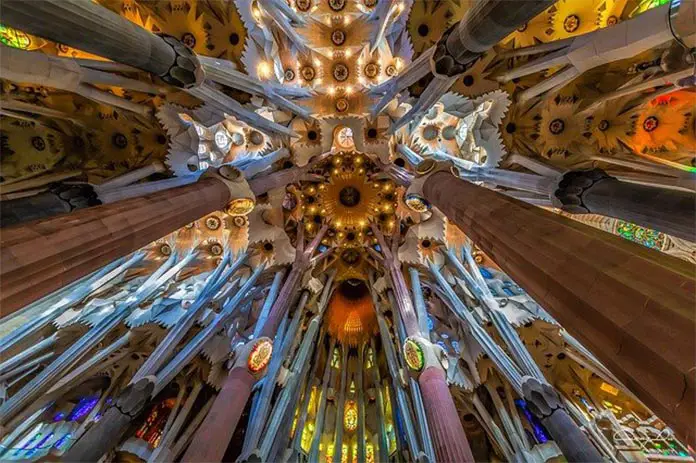
| Architect: Antoni Gaudi |
| Location: Barcelona, Spain |
| Construction period: 1882-? |
| Structure material: Stone, rocks, bricks, concrete |
| Architectural style: Neo-Gothic |
Another one of the most famous buildings in the world is the Sagrada Familia located in Barcelona. Spanish architect Antoni Gaudi‘s masterpiece, whose construction began in 1882, is scheduled to be completed in 2026. That’s why it’s called the Unfinished Church.
Gaudi combined Neo-gothic and Art-nouveau styles in the design and was inspired by the natural elements. This landmark of Barcelona has a height of 172 meters, which will make it the tallest church in the world when the building is completed.
Read Also: The Sagrada Familia | The Unfinished Church of Barcelona
9. Pompidou Center | Renzo Piano
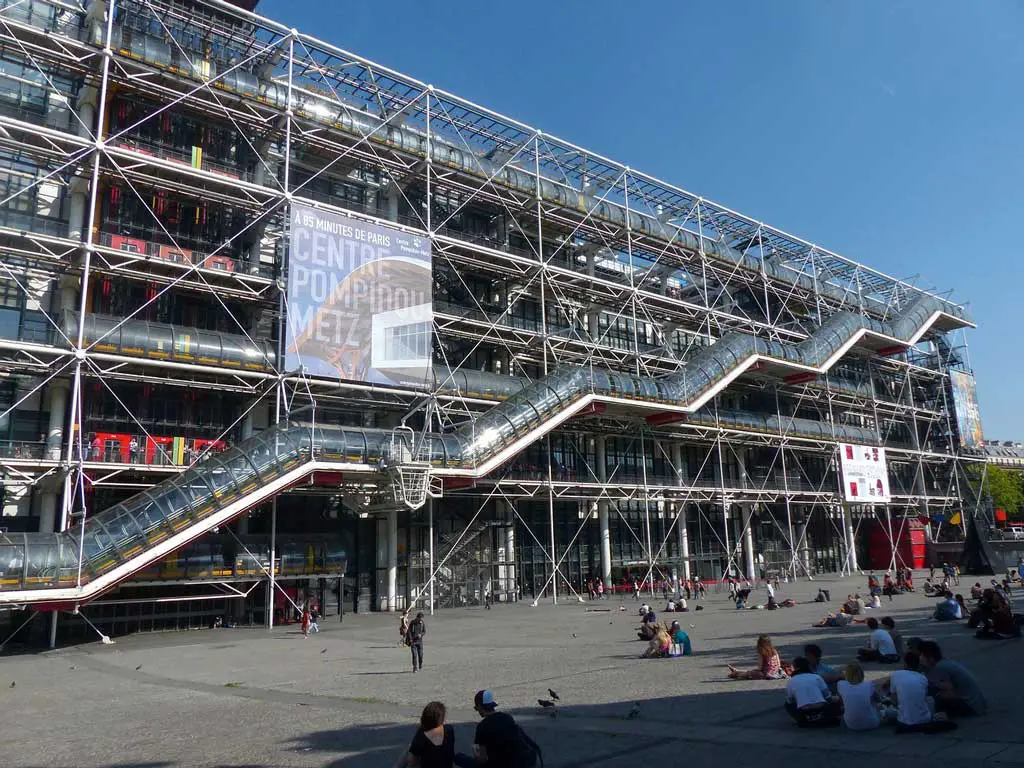
| Architect: Renzo Piano and Richard Rogers |
| Location: Paris, France |
| Construction period: 1971-1977 |
| Structure material: Steel |
| Architectural style: Brutalist architecture, High-tech |
As the winners of the competition, Renzo Piano and Richard Rogers designed this iconic structure in 1971. The building keeps service and circulation components like heating and ventilation pipes, stairs and lifts outside. This unfinished appearance of the rectangle mass adds dynamism to the museum building and turns itself into an exhibition piece.
Located near the front street, Pompidou Centre leaves behind a huge public area to let visitors enjoy the building from there. After its construction was completed, a great number of architects were inspired by the design philosophy of Centre Pompidou. The building functions as a museum and library nowadays.
Read Also: The Centre Pompidou Architecture | Piano & Rogers
10. The Shed | Diller Scofidio + Renfro

| Architect: Diller Scofidio + Renfro |
| Location: New York, USA |
| Construction period: 2015-2019 |
| Structure material: Steel |
| Architectural style: Kinetic architecture, Avant-garde style |
Hudson Yards in New York City hosts many influential architectural works and the Shed designed by the innovative architecture studio Diller Scofidio + Renfro made a splash quickly. The structure takes its name from its shell, which can be moved toward the public space in front of the building.
This phenomenal kinetic design expands activity areas of the Shed building outwards. By this means, the front public space and the structure become more integrated. Moreover, the building spreading over a horizontal axis balances the height of the Bloomberg building.
Read Also: The Shed NYC: A Unique Blend of Architecture & Art
11. Barcelona Pavilion | Ludwig Mies van der Rohe
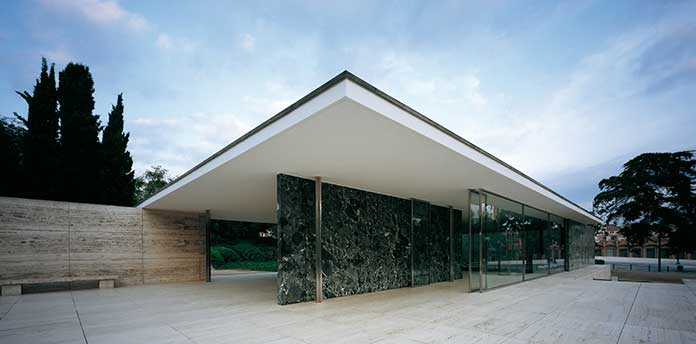
| Architect: Ludwig Mies van der Rohe |
| Location: Barcelona, Spain |
| Construction period: 1929 |
| Structure material: Steel |
| Architectural style: Modern architecture, Bauhaus, International style |
In the early 20th century, world fairs were quite popular. Thousands of artists, including architects, used to be invited to these fairs to showcase their works, which were temporarily designed for the fair.
The 1929 International Fair in Barcelona has critical importance in modern architecture history because Mies van der Rohe designed the Barcelona Pavilion here. It is one of the most famous Mies van der Rohe buildings.
Although the original building was demolished after the fair was over, a 1/1 scale replica was designed in the same place. Having a free plan, the building expands on the ground level. Its white and thick roof looks as if it’s flying. Barcelona Pavilion reflects the modern identity of the German people after the first world war.
Read Also: Barcelona Pavilion by Mies van der Rohe | Architecture Analysis
12. World Trade Center Transportation Hub | Santiago Calatrava
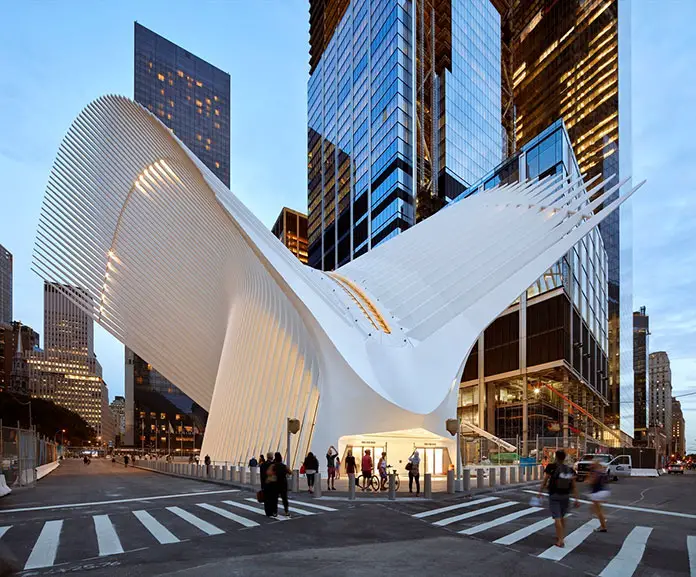
| Architect: Santiago Calatrava |
| Location: New York, USA |
| Construction period: 2004-2016 |
| Structure material: Steel |
| Architectural style: Postmodern architecture |
World Trade Center Transportation Hub, alias Oculus, is among the most famous architectural structures in the world. Located in near of the Twin Towers of the original World Trade Center, this iconic structure was designed by Santiago Calatrava in 2004. The main materials of the building are steel ribs and glass.
Resembling a bird flapping its wings, Oculus has a glass array in an elliptical shape on the roof. By this means, daylight coming through the roof lightens the transportation hub. If you’re planning to visit New York, don’t forget to see this notable building.
13. Louvre Pyramid | I. M. Pei
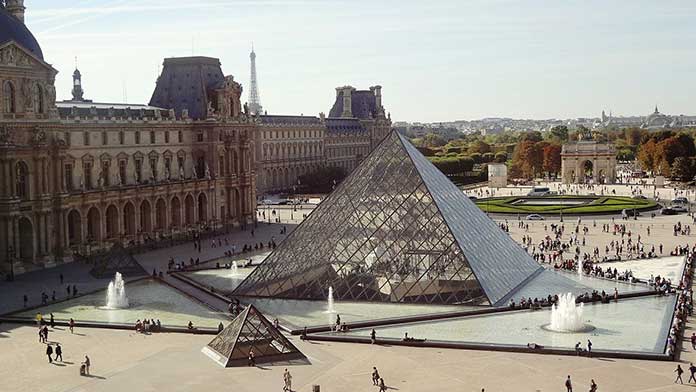
| Architect: Ieoh Ming Pei |
| Location: Paris, France |
| Construction period: 1983-1989 |
| Structure material: Steel |
| Architectural style: Modern architecture |
Built in the historical courtyard of the Louvre Museum in 1989 in Paris, the Grand Louvre Pyramid has hundreds of glass pieces. Architect I. M. Pei has brought a modern touch to this tremendous historical context. The fact that the Louvre Museum hosts the famous Mona Lisa painting and is one of the most visited museums in the world makes things even more interesting for the pyramid structure as it attracts all the attention today.
Louvre Pyramid includes underground galleries beneath this transparent pyramid mass. While the old museum building is the world’s largest art museum, additional gallery spaces were neded, so the pyramid structures were built as an extension of this building. This pure pyramid has already taken its place among the modern classics.
14. Sydney Opera House | Jørn Utzon
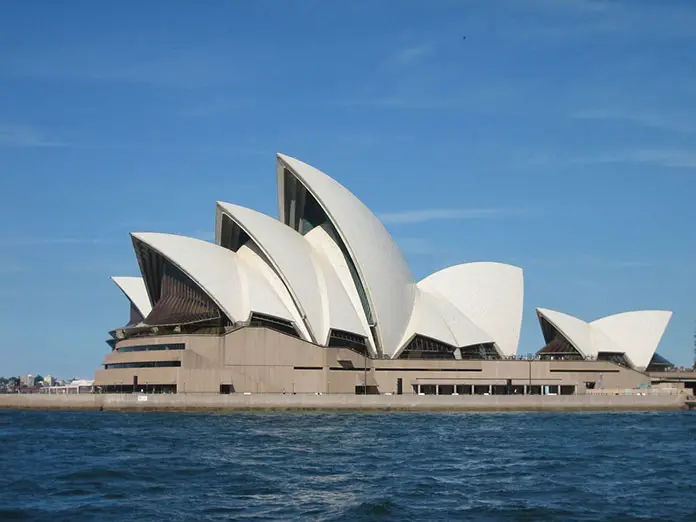
| Architect: Jørn Utzon |
| Location: Sydney, Australia |
| Construction period: 1957-1973 (built in 4 stages) |
| Structure material: Reinforced concrete |
| Architectural style: Expressionist architecture |
The Sydney Opera House is an iconic building located in Sydney, Australia. Designed by Danish architect Jørn Utzon, it was completed in 1973. Sydney Opera House stands out with its interesting and impressive mass design. The mass consists of concrete shells that shade each other.
Pritzker-winning architect Jørn Utzon has made a mark with this masterpiece of modern architecture. The building is considered a symbol of Australia and Sydney. Moreover, the Sydney Opera House is among the UNESCO World Heritage Sites since 2007.
15. Eiffel Tower | Gustave Eiffel

| Architect: Stephen Sauvestre, Maurice Koechlin, Émile Nouguier |
| Location: Paris, France |
| Construction period: 1887-1889 |
| Structure material: Wrought-iron |
| Architectural style: No spesific architectural style |
Each major city has an iconic structure as a signature and when it comes to Paris, most people would probably say it’s Eiffel Tower. It is the modern face of Paris and is one of the most remarkable structures in the world. The engineer of the tower, Gustave Eiffel, used almost 7500 tons of iron in this gigantic structure.
This masterpiece of the early industrial age was built for the 1889 World Fair in Paris. Having a height of approximately 324m (1,063 feet), Eiffel is the tallest structure in Paris and also it was the tallest structure in the world until 1930. The tower attracts almost 8 million tourists every year.
16. Taj Mahal | Ustad Ahmad Lahori
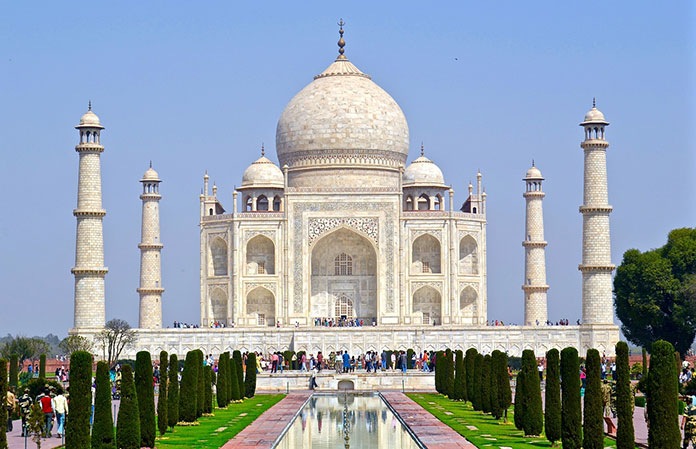
| Architect: Ustad Ahmad Lahori |
| Location: Agra, India |
| Construction period: 1631-1653 |
| Structure material: Ivory-white marble |
| Architectural style: Mughal architecture |
Taj Mahal was built as a gift for the Mumtaz Mahal, who was the wife of the Mughal emperor Shah Jahan. The building was just a gift of a lover man to his dear. However, even after hundreds of years, it continues to impress billions of people. The structure is so popular that it is among the 7 Wonders of the World.
Being a mausoleum structure, the building has absolute symmetry and is made with ivory-white marble. Taj Mahal has been in the list of UNESCO World Heritage Sites since 1982.
17. Pantheon | Hadrian

| Architect: Emperor Hadrian & Apollodorus of Damascus |
| Location: Rome, Italy |
| Construction period: 118-128 AD |
| Structure material: Concrete |
| Architectural style: Ancient Roman architecture |
Roman Empire had developed a magnificent civilization thanks to the help of its architecture and engineering knowledge. There are many masterpieces remaining from Rome, and most of them are located in the city of Italy, Rome. Dedicated to all the gods believed in Rome, Pantheon Temple was built by Emperor Hadrian in 118-128 AD.
Pantheon was the most technological structure of its period and its dome which is made of concrete is still the largest concrete dome in the world over 2000 years. Moreover, plenty of architects from all over the world have been influenced by Pantheon’s design and architectural technology for thousands of years. More than 6 million people visit this gorgeous structure every year.
Read Also: Pantheon: A Timeless Marvel of Roman Architecture
18. Acropolis Museum | Bernard Tschumi
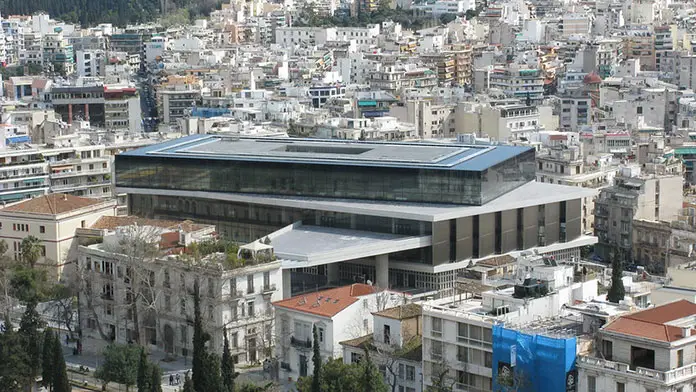
| Architect: Bernard Tschumi |
| Location: Athens, Greece |
| Construction period: 2001-2009 |
| Structure material: Reinforced concrete |
| Architectural style: Contemporary architecture |
Creating an immersive relationship with both the historical hill of Athens and the most important structure located on it, the Parthenon of Athens, New Acropolis Museum is a wonderful example of modern architectural thoughts emerging in a historical context. Bernard Tschumi designed the building after winning the competition in 2001.
The main reason why Acropolis Museum was designed is that there was a multitude of artifacts found on the hill so a museum building was needed to exhibit those archeological finds.
The New Acropolis Museum building consists of 3 main parts, each of which has a different relationship with this historical city. The lowest section, which rises on numerous inner columns, reveals artifacts found in the archaeological site below the building area. Having a glass facade, the second part turns Parthenon Hill into an exhibition area which you can watch distantly. The last section hosts the Parthenon frieze and sculptures gathered from the hill.
Read Also: New Acropolis Museum of Athens | Bernard Tschumi
19. Parthenon Temple
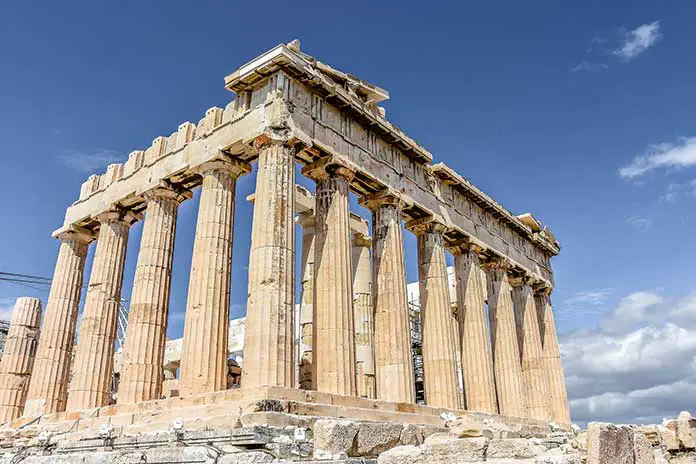
| Architect: Icnitus & Callicrates |
| Location: Athens, Greece |
| Construction period: 447-432 BC |
| Structure material: Pentelic marble, limestone |
| Architectural style: Doric order |
Just like Romans, Greeks were very adept at building structures and the peak of ancient Greek architecture was the Temple of Parthenon on the Acropolis of Athens. Dedicated to the Goddess Athena, the temple had many statues and reliefs made by the famous sculptor Phidias. This monumental building is also the most famous example of Doric order architecture.
Parthenon has been exposed to various changes throughout history. Earthquakes, wars and different religions have changed its appearance, and fortunately, a part of the Parthenon still stands today.
Read Also: Parthenon of Athens in Acropolis | Facts & Architecture
20. Lotus Temple | Fariborz Sahba
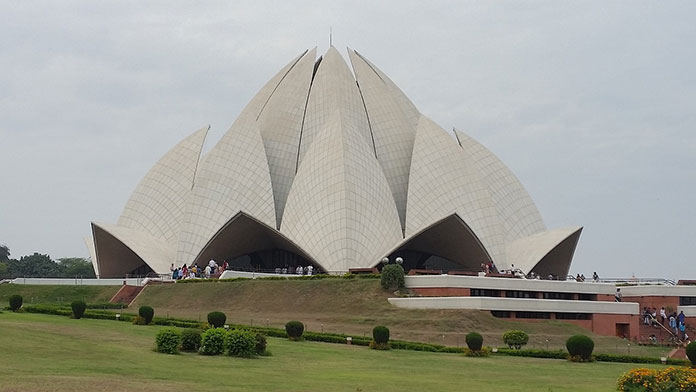
| Architect: Fariborz Sahba |
| Location: Delhi, India |
| Construction period: 1980-1986 |
| Structure material: Concrete |
| Architectural style: Expressionist architecture |
Lotus Temple in India is a religious building open to any people. The feature that makes it famous is its unique shell design with a total of 27 petals grouped in threes. This means there are 9 groups or 9 sides that you are able to enter the building, which is capable of accommodating up to 2500 visitors simultaneously.
These 9 entrance gates open onto the center hall with an interior height of approximately 40 meters.
The shell covering the Lotus Temple was made with a kind of white marble gathering from Greece. Designed by the Iranian architect Fariborz Sahba, the conceptual design of the temple evokes peace, happiness and innocence.
21. The Leaning Tower | Diotisalvi
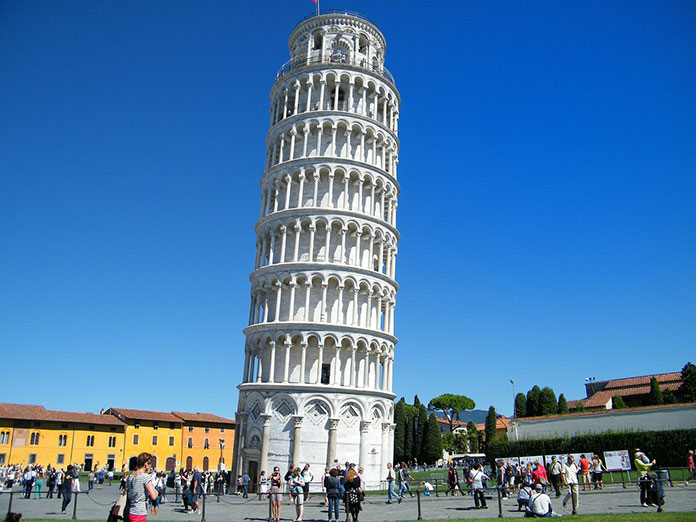
| Architect: Diotisalvi & Bonanno Pisano |
| Location: Pisa, Italy |
| Construction period: 1173-1372 |
| Structure material: White marble |
| Architectural style: Romanesque architecture |
The Leaning Tower of Pisa Cathedral was built in 3 phases, which took about 199 years in total. Due to its leaning structure, the tower is among the most famous buildings in the world. The reason why it’s leaning is that one side of the ground on which it is located is very soft.
In the 20th century, engineers accomplished to stabilize its slope with the developed building technologies. Having over 207 columns around, it’s one of the most outstanding examples of Romanesque architectural style. The Leaning Tower used to function as the bell tower of the cathedral complex.
22. Empire States Building
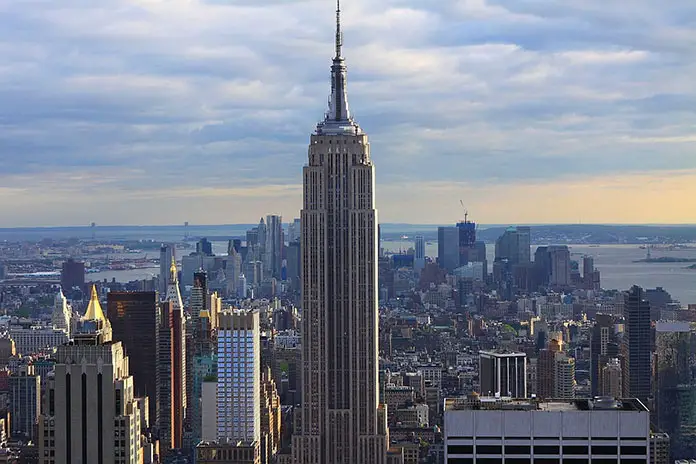
| Architect: Shreve, Lamb & Harmon |
| Location: New York, USA |
| Construction period: 1930-1931 |
| Structure material: Steel |
| Architectural style: Art Deco |
Having a height of 380m (1250 ft) and 102 floors, the Empire States building had been the tallest skyscraper in the world for 40 years. This world-famous landmark of New York City was built in 1930-1931. While many structures taller than the Empire States were built latterly, this one has remained as the most recognizable skyscraper.
Conclusion
Consequently, millions of important structures have been built throughout history and many of them attract millions of people from all over the world. We, Archeetect.com, have prepared our list of the most famous architectural buildings in the world. These unique architectural structures belong to different periods of history, including the ancient age, medieval and industrial periods as well as modern times.
Please feel free to make comments about the compilation and share your favorite buildings on the list with us.
Related Articles:
















